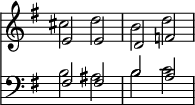48.—Far more often, however, it is necessary to omit naturals used to contradict an accidental occurring in a part which is not being copied. Thus, in the following extract from the tune "Endless Alleluia," the natural in both the tenor and bass would be unnecessary were these parts written out separately from the other parts and each other.

Fig. 38.
(The A sharp in the tenor of this extract suggests C sharp so strongly apart from the rest of the harmony, that the natural is almost a necessity even had the previous treble C sharp not been included. Not being required according to rule, however, it should be enclosed in brackets a not infrequent, and very commendable, device with careful writers, when an accidental is desirable but not necessary according to rule.)
49.—The stems, of course, must be turned up or down according to their position above or below the middle line, and not as in the short score.
